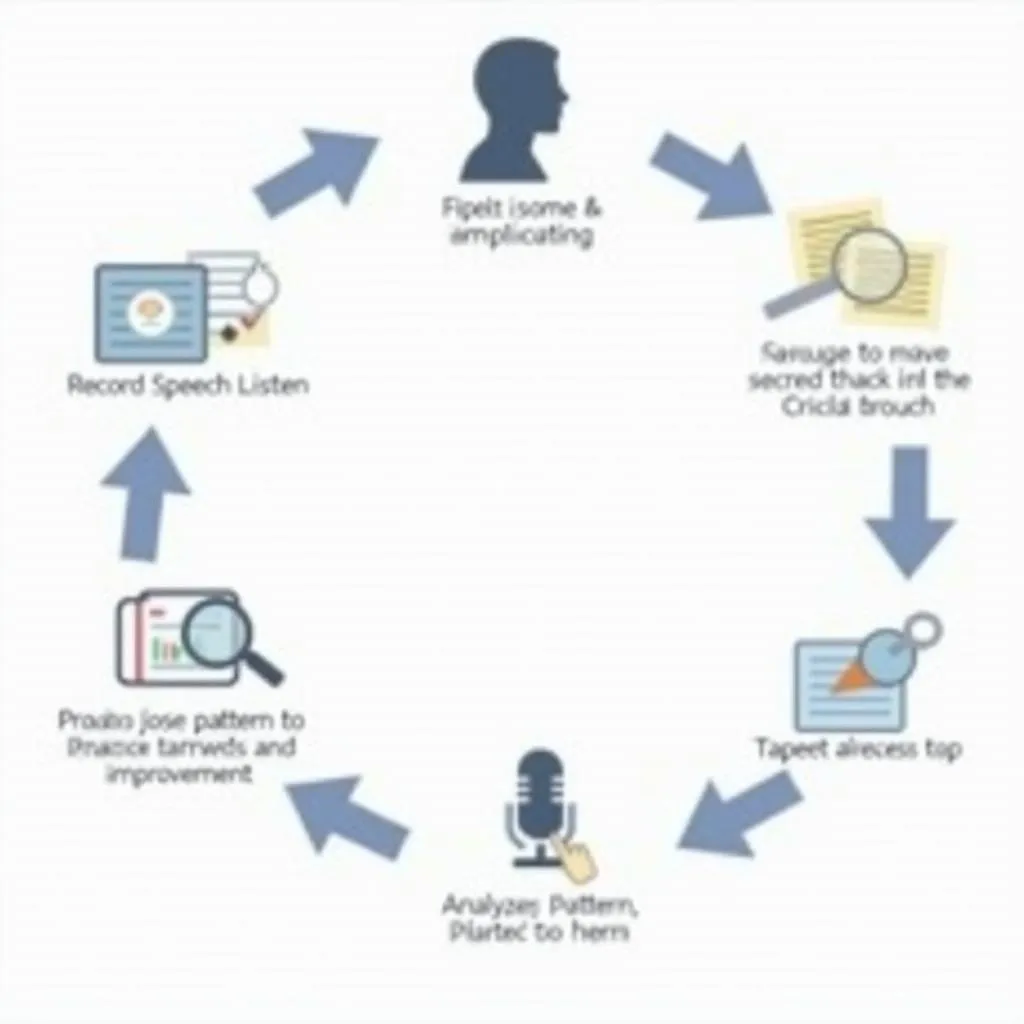Developing fluent speech is crucial for success in the PTE Academic speaking section. Many test-takers struggle with hesitations and pauses that can significantly impact their scores. This comprehensive guide will explore effective strategies to practice speaking without hesitation, helping you boost your confidence and achieve your desired PTE score.
Understanding the Importance of Fluency in PTE Speaking
Fluency is a key component of the PTE speaking section, directly affecting your oral fluency score. Speaking without hesitation demonstrates your ability to express ideas coherently and naturally in English. PTE speaking section fluency tips are essential for mastering this crucial skill.
The Impact of Hesitations on Your PTE Score
Frequent pauses and hesitations can:
- Lower your oral fluency score
- Reduce your pronunciation score
- Negatively affect your overall speaking performance
To avoid these pitfalls, it’s crucial to develop strategies for smooth, continuous speech.
Effective Techniques to Eliminate Hesitations
1. Shadowing: Mimic Native Speakers
Shadowing involves listening to native English speakers and repeating what they say in real-time. This technique helps improve your rhythm, intonation, and fluency.
Steps to practice shadowing:
- Choose a short audio clip (1-2 minutes) from a native English speaker
- Listen to the clip once to understand the content
- Play the audio again and repeat what you hear simultaneously
- Focus on matching the speaker’s pace and intonation
- Repeat this process several times until you can shadow comfortably
 Shadowing technique for PTE speaking practice
Shadowing technique for PTE speaking practice
2. Practice with Tongue Twisters
Tongue twisters are an excellent way to improve articulation and reduce hesitations. They challenge your mouth muscles and train your brain to process and produce speech quickly.
Some effective tongue twisters for PTE practice:
- “Peter Piper picked a peck of pickled peppers”
- “She sells seashells by the seashore”
- “How much wood would a woodchuck chuck if a woodchuck could chuck wood?”
Practice these daily, gradually increasing your speed while maintaining clarity.
3. Utilize the 4-3-2 Technique
This time-based speaking exercise helps improve fluency and reduce hesitations. How to practice oral fluency with PTE materials often includes this effective method.
Steps for the 4-3-2 technique:
- Choose a topic from the PTE speaking section
- Speak about the topic for 4 minutes, recording yourself
- Speak about the same topic for 3 minutes, trying to include all key points
- Finally, condense your speech to 2 minutes, focusing on fluency and key information
This technique trains you to speak more efficiently and reduces the tendency to hesitate or pause.
Overcoming Mental Barriers to Fluent Speech
1. Build Confidence Through Regular Practice
Confidence is key to speaking without hesitation. The more you practice, the more comfortable you’ll become with expressing yourself in English.
Tips for building confidence:
- Set aside dedicated practice time each day
- Record yourself speaking and listen for improvements
- Join English conversation groups or find a language exchange partner
2. Embrace Mistakes as Learning Opportunities
Fear of making mistakes often leads to hesitations. Remember that errors are a natural part of language learning.
Dr. Emma Thompson, a renowned PTE coach, advises:
“Embrace your mistakes as stepping stones to fluency. Each error you make and correct is a step closer to mastering the language.”
3. Develop a Positive Mindset
Approach your PTE speaking practice with a growth mindset. Believe in your ability to improve and see challenges as opportunities for growth.
 Positive mindset visualization for PTE speaking practice
Positive mindset visualization for PTE speaking practice
Practical Exercises to Enhance Fluency
1. Timed Speaking Drills
Regular timed speaking exercises can significantly improve your ability to speak without hesitation. How to improve oral fluency for PTE often emphasizes the importance of these drills.
Try this exercise:
- Choose a PTE speaking topic
- Set a timer for 40 seconds
- Speak on the topic without stopping until the timer ends
- Gradually increase the time as you become more comfortable
2. Paraphrasing Practice
Paraphrasing helps you think quickly in English and reduces the need for hesitations when searching for words.
Steps for effective paraphrasing:
- Read a short paragraph from a PTE practice material
- Close the text and immediately restate the main ideas in your own words
- Compare your version with the original to ensure accuracy
- Practice this regularly with various texts
3. Impromptu Speaking Challenges
Improve your ability to speak spontaneously by giving yourself impromptu speaking challenges.
Ideas for impromptu speaking:
- Describe objects around you for 1 minute without pausing
- Explain your daily routine in detail without hesitation
- Share your opinion on random topics for 30 seconds each
Leveraging Technology for Fluency Practice
1. Use Speech Recognition Software
Speech recognition tools can help you identify areas where you hesitate or pause frequently. Practice speaking into these programs and analyze the transcript to pinpoint areas for improvement.
2. Utilize Language Learning Apps
Many language learning apps offer speaking exercises that can help you practice fluency on the go. Look for apps with speech recognition features that provide instant feedback on your pronunciation and fluency.
3. Record and Analyze Your Speech
Regularly recording yourself speaking can be a powerful tool for improvement. How to avoid long pauses in PTE speaking often recommends this technique.
Steps for effective self-analysis:
- Record yourself speaking on various PTE topics
- Listen to the recordings and note any hesitations or pauses
- Identify patterns in your speech that lead to hesitations
- Focus on improving these specific areas in your practice sessions
 Self-analysis process for PTE speaking improvement
Self-analysis process for PTE speaking improvement
Common Pitfalls to Avoid
While practicing speaking without hesitation, be aware of these common mistakes:
- Speaking too fast: Aim for a natural pace, not rushed speech
- Neglecting pronunciation: Fluency should not come at the expense of clear pronunciation
- Overusing filler words: Replace “um” and “uh” with brief pauses
- Ignoring content quality: Focus on both fluency and meaningful content
PTE oral fluency common pitfalls provides more detailed insights into these issues and how to avoid them.
Conclusion
Mastering the art of speaking without hesitation is a journey that requires consistent practice and dedication. By incorporating these strategies into your PTE preparation routine, you’ll significantly improve your fluency and boost your confidence in the speaking section. Remember, fluent speech is not about perfection but about communicating effectively and naturally. Keep practicing, stay positive, and watch your PTE speaking scores soar!
Frequently Asked Questions
How long should I practice speaking without hesitation each day for PTE?
Aim for at least 30 minutes of focused practice daily. Consistency is key, so even 15 minutes every day is better than longer, irregular sessions.
Can reading aloud help improve my speaking fluency for PTE?
Yes, reading aloud can significantly improve your fluency. It helps you practice pronunciation, rhythm, and continuous speech without the pressure of generating content.
What should I do if I blank out during the PTE speaking test?
If you blank out, take a brief pause, breathe, and try to rephrase your thoughts. It’s better to pause briefly than to use filler words excessively.
How can I reduce my accent to speak more fluently in the PTE test?
Focus on clear pronunciation rather than eliminating your accent entirely. Practice stress patterns and intonation of English to improve overall fluency and clarity.
Is it helpful to memorize phrases for the PTE speaking section?
While having a repertoire of useful phrases can be helpful, avoid over-relying on memorized content. Focus on understanding and expressing ideas naturally.